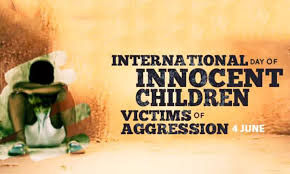The Silent Suffering: Honoring Innocent Children Victims of Aggression
- okolobicynthia
- Jun 4
- 3 min read

Did you know that every year on June 4th, the world marks the International Day of Innocent Children Victims of Aggression?. It's not just a day on the calendar — it's a haunting reminder of the unspeakable injustices faced by the most vulnerable members of our society: children. From war zones and refugee camps to domestic settings and marginalized communities, millions of children live in constant fear, pain, and trauma due to violence they never asked for — and often, never understand.
Why This Day Matters
This day was first established in 1982 by the United Nations in response to the horrific impact of the Lebanon conflict on children. But decades later, the same images resurface: children holding onto teddy bears in bombed-out buildings, walking miles with blistered feet to escape war, or lying in hospital beds with eyes too hollow for their age.
While global conflicts, abuse, exploitation, and human trafficking rage on, children are caught in the crossfire — not as collateral damage, but as victims in their own right.
The Faces Behind the Statistics
It’s easy to get lost in the numbers:
Over 400 million children live in conflict zones.
1 in 6 children globally is affected by armed conflict.
In 2023 alone, thousands were killed or maimed in war.

But beyond these statistics are stories. A six-year-old who can't sleep without nightmares. A teenager who lost both parents in a drone strike. A toddler learning to walk in a refugee camp with no shoes and no home. Each of these lives reflects resilience — but also a failure of humanity.
Forms of Aggression Children Face
Aggression against children takes many forms, and not all are visible:
Armed conflict – Children are killed, maimed, orphaned, or recruited as soldiers.
Sexual violence – Girls and boys are subjected to rape and exploitation during war and even in so-called “safe” places.
Psychological trauma – Years of conflict or abuse leave scars that no bandage can heal.
Displacement – Millions grow up in refugee camps, robbed of education, safety, and hope.
Domestic and societal violence – From corporal punishment to gang violence, not all aggression happens in war zones.
The Role of the Global Community
The question we must all ask is: What are we doing to protect our children?
Governments and global institutions must do more than just condemn violence. They must act — by enforcing international laws that protect children, funding mental health and reintegration programs, and holding perpetrators accountable.
But beyond policy, we, the citizens of the world, must care — truly care. Whether it's by raising awareness, supporting NGOs, donating to child protection causes, or simply refusing to look away, each action contributes to building a safer world for children.
Hope in Action
Despite the darkness, stories of hope shine through:
Children’s peace clubs in conflict-prone areas teach meditation and healing.
Therapeutic art programs help child survivors express pain and rediscover joy.
Global youth advocates, many once victims themselves, are using their voices to speak out and lead change.
These initiatives prove that children are not just passive victims — they can be powerful agents of peace and healing when given the chance.
A Call to Humanity
The International Day of Innocent Children Victims of Aggression is not just about mourning — it’s about awakening. Awakening to the brutal reality that even in the 21st century, children are still being hurt by adult wars and negligence. It’s a call to renew our humanity and protect the very future we claim to care about.
Because every child deserves not just to survive but to thrive.










Comments